|
|
|
Sort Order |
|
|
|
Items / Page
|
|
|
|
|
|
|
| Srl | Item |
| 1 |
ID:
124716
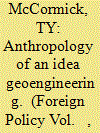

|
|
|
|
|
| Publication |
2013.
|
| Summary/Abstract |
The article provides various historical anecdotes regarding efforts to engineer weather and climate. It includes the 1841 theories of American meteorologist James Pollard Espy to promote rain by igniting massive fires, the 1896 findings by Swedish chemist Svante Arrhenius that found a direct correlation between a rise in carbon dioxide levels and rising temperatures across the globe, and the 1967-1972 Operation Popeye which used cloud seeding as a U.S. military tactic during the Vietnam War and its associated military operations in Cambodia and Laos.
|
|
|
|
|
|
|
|
|
|
|
|
|
|
|
|
| 2 |
ID:
110389
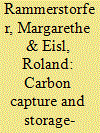

|
|
|
|
|
| Publication |
2011.
|
| Summary/Abstract |
The following article deals with real options modeling for investing into carbon capture and storage technologies. Herein, we derive two separate models. The first model incorporates a constant convenience yield and dividend for the investment project. In the second model, the convenience yield is allowed to follow a mean reverting process which seems to be more realistic, but also increases the model's complexity. Both frameworks are to be solved numerically. Therefore, we calibrate our model with respect to empirical data and provide insights into the models' sensitivity toward the chosen parameter values. We found that given the recently observable prices for carbon dioxide, an investment into C O2-storage facilities is not profitable.
|
|
|
|
|
|
|
|
|
|
|
|
|
|
|
|
| 3 |
ID:
118272


|
|
|
|
|
| Publication |
2013.
|
| Summary/Abstract |
The dual forces of population growth and climate change will exacerbate pressures on land use, water access, and food security.
|
|
|
|
|
|
|
|
|
|
|
|
|
|
|
|
| 4 |
ID:
112345


|
|
|
|
|
| Publication |
2012.
|
| Summary/Abstract |
For too long, climate diplomacy has focused on carbon dioxide. But at least 40 percent of global warming can be blamed on shorter-lived pollutants, which also cause disease and damage crops in developing states. Reining in pollution would thus accomplish two goals, while finally getting countries such as China and India into the climate-change business.
|
|
|
|
|
|
|
|
|
|
|
|
|
|
|
|
| 5 |
ID:
151007


|
|
|
|
|
| Summary/Abstract |
The Paris Agreement on Climate Change was adopted at the close of the 21st Conference of Party on 12 December 2015. This agreement has been approved after a marathon negotiation in which parties under the aegis of the United Nations have finally agreed on the terms and conditions to implement it by 2020. The prime objective of the Paris Agreement is to ensure member states of the United Nations take appropriate and concrete actions in combating the menace of climate change that poses a challenging threat to humanity. It includes keeping temperature rise below 2°C by this century and limiting the temperature increase even further to 1.5°C above the pre-industrial levels. India has announced voluntary pledges during the conference which include carbon intensity growth by 33–35 per cent over the 2005 level, to raise the share of non-fossil fuel power to 40 per cent by 2030 and to produce 175 gigawatt (GW) of renewable power by 2022. Hence, the basic objective of this article is to examine India’s commitments and its initiatives to combat climate change in line with the Paris framework agreement to be implemented by 2020 and also to highlight the implications and drawbacks which India confronted.
|
|
|
|
|
|
|
|
|
|
|
|
|
|
|
|
| 6 |
ID:
125482


|
|
|
|
|
| Publication |
2013.
|
| Summary/Abstract |
As climate change and the regulation of carbon dioxide emissions play an increasingly important role in the global policy debate, careful consideration of the state-level determinants driving emissions must be considered. The importance of state-level determinants in the transmission of carbon dioxide matters especially for a country that differs from coast to coast in energy use and industry makeup like the United States. To add to the policy debate this paper estimates two models that account for the dynamic nature of emissions of carbon dioxide emissions at the state-level from 1980-2010 while taking account of scale, technique, and composition effects. When stochastic trends are taken account of, an environmental Kuznets curve relationship with a feasible turning point is found for carbon dioxide emissions.
|
|
|
|
|
|
|
|
|
|
|
|
|
|
|
|
| 7 |
ID:
104972


|
|
|
|
|
| Publication |
2011.
|
| Summary/Abstract |
Presented in this study is an empirical analysis of embodied carbon dioxide emissions induced by fossil fuel combustion for the world divided into three supra-national coalitions, i.e., G7, BRIC, and the rest of the world (ROW), via the application of a multi-region input-output modeling for 2004. Embodied emission intensities for the three coalitions are calculated and compared, with market exchange rate and purchase power parity separately used to investigate the difference between nominal and real production efficiencies. Emissions embodied in different economic activities such as production, consumption, import, and export are calculated and analyzed accordingly, and remarkable carbon trade imbalances associated with G7 (surplus of 1.53 billion tons, or 36% its traded emissions) and BRIC (deficit of 1.37 billion tons, or 51% its traded emissions) and approximate balance with ROW (deficit of 0.16 billion tons, or 3% its traded emissions) are concretely revealed. Carbon leakages associated with industry transfer and international trades are illustrated in terms of impacts on global climate policies. The last but not least, per capita consumption based emissions for G7, BRIC, and ROW are determined as 12.95, 1.53, and 2.22 tons, respectively, and flexible abatement policies as well as equity on per capita entitlement are discussed.
|
|
|
|
|
|
|
|
|
|
|
|
|
|
|
|
| 8 |
ID:
125627


|
|
|
|
|
| Publication |
2013.
|
| Summary/Abstract |
The aim of this paper is to investigate the environmental convergence hypothesis in carbon dioxide emissions for a large group of developed and developing countries from 1980 to 2009. The novel aspect of this work is that we distinguish among carbon dioxide emissions according to the source of energy (coal, natural gas and petroleum) instead of considering the aggregate measure of per capita carbon dioxide emissions, where notable interest is given to the regional dimension due to the application of new club convergence tests. This allows us to determine the convergence behaviour of emissions in a more precise way and to detect it according to the source of energy used, thereby helping to address the environmental targets. More specifically, the convergence hypothesis is examined with a pair-wise test and another one is used to test for the existence of club convergence. Our results from using the pair-wise test indicate that carbon dioxide emissions for each type of energy diverge. However, club convergence is found for a large group of countries, although some still display divergence. These findings point to the need to apply specific environmental policies to each club detected, since specific countries converge to different clubs.
|
|
|
|
|
|
|
|
|
|
|
|
|
|
|
|
| 9 |
ID:
097194


|
|
|
|
|
| Publication |
2010.
|
| Summary/Abstract |
Climate change is one of the most important issues our world faces today and it is responsible for a number of natural disasters that threaten human life and existence. Carbon dioxide, produced from almost every energy consuming activity, is the dominant greenhouse gas responsible for global warming. Water desalination is an energy intensive activity, and when it is powered by conventional energy sources, significant amounts of CO2 are released. For every cubic metre of fresh water produced, there is a 2 kg of CO2 reduction if renewable energy sources (RES) are used instead of electricity from the local grid. On the other hand, the cost of fresh water produced by desalination is much less if conventional sources of energy are used.
Making appropriate policy choices require information on both costs and benefits. So here we estimate the critical CO2 cost, above which desalination units should use renewable energy instead of conventional energy sources. It was found that the critical CO2 emissions cost can be close to the CO2 capture cost and in many cases less than the penalties imposed by the European Commission. Several case studies of water desalination in the Aegean islands verify the conclusions.
|
|
|
|
|
|
|
|
|
|
|
|
|
|
|
|
| 10 |
ID:
097195


|
|
|
|
|
| Publication |
2010.
|
| Summary/Abstract |
Climate change is one of the most important issues our world faces today and it is responsible for a number of natural disasters that threaten human life and existence. Carbon dioxide, produced from almost every energy consuming activity, is the dominant greenhouse gas responsible for global warming. Water desalination is an energy intensive activity, and when it is powered by conventional energy sources, significant amounts of CO2 are released. For every cubic metre of fresh water produced, there is a 2 kg of CO2 reduction if renewable energy sources (RES) are used instead of electricity from the local grid. On the other hand, the cost of fresh water produced by desalination is much less if conventional sources of energy are used.
Making appropriate policy choices require information on both costs and benefits. So here we estimate the critical CO2 cost, above which desalination units should use renewable energy instead of conventional energy sources. It was found that the critical CO2 emissions cost can be close to the CO2 capture cost and in many cases less than the penalties imposed by the European Commission. Several case studies of water desalination in the Aegean islands verify the conclusions.
|
|
|
|
|
|
|
|
|
|
|
|
|
|
|
|
| 11 |
ID:
086025


|
|
|
|
|
| Publication |
2009.
|
| Summary/Abstract |
Each year, the effects of climate change are coming into sharper focus. Barely a month goes by without some fresh bad news: ice sheets and glaciers are melting faster than expected, sea levels are rising more rapidly than ever in recorded history, plants are blooming earlier in the spring, water supplies and habitats are in danger, birds are being forced to find new migratory patterns.The odds that the global climate will reach a dangerous tipping point are increasing. Over the course of the twenty-first century, key ocean currents, such as the Gulf Stream, could shift radically, and thawing permafrost could release huge amounts of additional greenhouse gases into the atmosphere. Such scenarios, although still remote, would dramatically accelerate and compound the consequences of global warming. Scientists are taking these doomsday scenarios seriously because the steady accumulation of warming gases in the atmosphere is forcing change in the climate system at rates so rapid that the outcomes are extremely difficult to predict.Eliminating all the risks of climate change is impossible because carbon dioxide emissions, the chief human contribution to global warming, are unlike conventional air pollutants, which stay in the atmosphere for only hours or days. Once carbon dioxide enters the atmosphere, much of it remains for over a hundred years. Emissions from anywhere on the planet contribute to the global problem, and once headed in the wrong direction, the climate system is slow to respond to attempts at reversal. As with a bathtub that has a large faucet and a small drain, the only practical way to lower the level is by dramatically cutting the inflow. Holding global warming steady at its current rate would require a worldwide 60-80 percent cut in emissions, and it would still take decades for the atmospheric concentration of carbon dioxide to stabilize.
|
|
|
|
|
|
|
|
|
|
|
|
|
|
|
|
| 12 |
ID:
072608
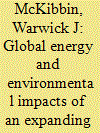

|
|
|
|
|
| Publication |
2006.
|
| Summary/Abstract |
China accounts for 10 percent of global energy use and will continue to rely on coal for generating approximately 75 percent of its energy over coming decades. The environmental problems associated with coal burning are a concern for China as well as regionally and globally. The present paper summarizes China's energy structure and likely future energy requirements, while exploring the impact of energy use on air quality, black carbon emission, sulphur dioxide (SO2) emissions, and carbon dioxide emissions. Although China has begun to take action on local environmental problems from energy, there is still much to be done. In particular, the problem of black carbon and carbon dioxide emissions needs to be addressed. The present paper proposes addressing carbon dioxide emissions through a longer-term strategy that acknowledges the need for China to continue to grow without a short-term carbon constraint but with clear pricing of the short-term and long-term cost of carbon dioxide.
|
|
|
|
|
|
|
|
|
|
|
|
|
|
|
|
| 13 |
ID:
124224


|
|
|
|
|
| Publication |
2013.
|
| Summary/Abstract |
This study attempts to examine the natural gas fired power plants in Iran. The required data from natural gas fired power plants were gathered during 2008. The characteristics of thirty two gas turbine power plants and twenty steam power plants have been measured. Their emission factor values were then compared with the standards of Energy Protection Agency, Euro Union and World Bank. Emission factors of gas turbine and steam power plants show that gas turbine power plants have a better performance than steam power plants. For economic analysis, fuel consumption and environmental damages caused by the emitted pollutants are considered as cost functions; and electricity sales revenue are taken as benefit functions. All of these functions have been obtained according to the capacity factor. Total revenue functions show that gas turbine and steam power plants are economically efficient at 98.15% and 90.89% of capacity factor, respectively; this indicates that long operating years of power plants leads to reduction of optimum capacity factor. The stated method could be implemented to assess the economic status of a country's power plants where as efficient capacity factor close to one means that power plant works in much better condition.
|
|
|
|
|
|
|
|
|
|
|
|
|
|
|
|
| 14 |
ID:
166724


|
|
|
|
|
| Summary/Abstract |
The price of electricity for European end users typically fell until development of wind and solar energy began, but has increased since then. We estimate the savings in CO2 emissions due to solar and wind energy and calculate what end users pay per tonne CO2, assuming that price increases since the introduction of solar and wind power are due to these types of energy. These payments are in most cases well above even high and unlikely estimates of the cost of carbon and in some cases several times as high.
|
|
|
|
|
|
|
|
|
|
|
|
|
|
|
|
| 15 |
ID:
098619


|
|
|
|
|
| Publication |
2010.
|
| Summary/Abstract |
This study analyzes the changes in carbon dioxide (CO2) emissions resulting from the movement of containers from established ports through the emerging port of Taipei in Northern Taiwan. An activity-based emissions model is used to estimate the CO2 emissions of container transport under four scenarios where there are switches of market share from existing ports to the emerging port. The results show that there are greater reductions in CO2 when transhipment routes are changed from the ports of Kaohsiung, Taichung and Keelung to the emerging port of Taipei. The paper concludes that the analytical approach adopted in the paper can help decision-makers understand potential CO2 emissions reduction strategies in the route selection of inland container transportation and such consideration should provide a broader and more meaningful basis for the socio-economic evaluation of port investment projects.
|
|
|
|
|
|
|
|
|
|
|
|
|
|
|
|
| 16 |
ID:
151005
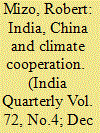

|
|
|
|
|
| Summary/Abstract |
The Paris Agreement on Climate Change was adopted at the close of the 21st Conference of Party on 12 December 2015. This agreement has been approved after a marathon negotiation in which parties under the aegis of the United Nations have finally agreed on the terms and conditions to implement it by 2020. The prime objective of the Paris Agreement is to ensure member states of the United Nations take appropriate and concrete actions in combating the menace of climate change that poses a challenging threat to humanity. It includes keeping temperature rise below 2°C by this century and limiting the temperature increase even further to 1.5°C above the pre-industrial levels. India has announced voluntary pledges during the conference which include carbon intensity growth by 33–35 per cent over the 2005 level, to raise the share of non-fossil fuel power to 40 per cent by 2030 and to produce 175 gigawatt (GW) of renewable power by 2022. Hence, the basic objective of this article is to examine India’s commitments and its initiatives to combat climate change in line with the Paris framework agreement to be implemented by 2020 and also to highlight the implications and drawbacks which India confronted.
|
|
|
|
|
|
|
|
|
|
|
|
|
|
|
|
| 17 |
ID:
099421


|
|
|
|
|
| Publication |
Washington, DC, World Bank, 2010.
|
| Description |
xviii, 156p.
|
| Standard Number |
9780821381229
|
|
|
|
|
|
|
|
|
|
|
|
Copies: C:1/I:0,R:0,Q:0
Circulation
| Accession# | Call# | Current Location | Status | Policy | Location |
| 055303 | 363.7387460972/JOH 055303 | Main | On Shelf | General | |
|
|
|
|
| 18 |
ID:
101457


|
|
|
|
|
| Publication |
2010.
|
| Summary/Abstract |
The contribution of aviation to global carbon dioxide (CO2) emissions is projected to triple by 2050. As nations strive to meet CO2 reduction targets, policy interventions to manage the growth of emissions arising from air travel are likely. Here, we investigate the potential influence of aviation emissions reduction policies on the business travel patterns of individual corporations. Using travel data from six UK-based companies, we find that increased ticket prices can deliver substantial emissions cuts, particularly on premium class flights, and may provide strong financial incentives to seek modal and/or technological alternatives to flying. We also find that corporations from different business sectors vary in their responsiveness to a range of policy options. Finally, we examine questionnaire data to determine whether companies more broadly are going beyond compliance to mitigate their environmental impact by managing travel-related emissions voluntarily. Although many corporations are measuring and reporting emissions, only a limited number are willing to implement in-house reduction policies prior to regulation.
|
|
|
|
|
|
|
|
|
|
|
|
|
|
|
|
| 19 |
ID:
094212
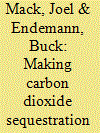

|
|
|
|
|
| Publication |
2010.
|
| Summary/Abstract |
As the United States moves closer to a national climate change policy, it will have to focus on a variety of factors affecting the manner in which the country moves toward a future with a substantially lower carbon footprint. In addition to encouraging renewable energy, smart grid, clean fuels and other technologies, the United States will need to make substantial infrastructure investments in a variety of industries. Among the significant contributors to the current carbon footprint in the United States is the use of coal as a major fuel for the generation of electricity. One of the most important technologies that the United States can employ to reduce its carbon footprint is to sequester the carbon dioxide ("CO2") from coal-fired power plants. This article focuses on the legal and policy issues surrounding a critical piece of the necessary sequestration infrastructure: CO2 pipelines that will carry CO2 from where it is removed from fuel or waste gas streams to where it will be sequestered. Ultimately, this article recommends developing a federally regulated CO2 pipeline program to foster the implementation of carbon sequestration technology.
|
|
|
|
|
|
|
|
|
|
|
|
|
|
|
|
| 20 |
ID:
093610


|
|
|
|
|
|
|
|